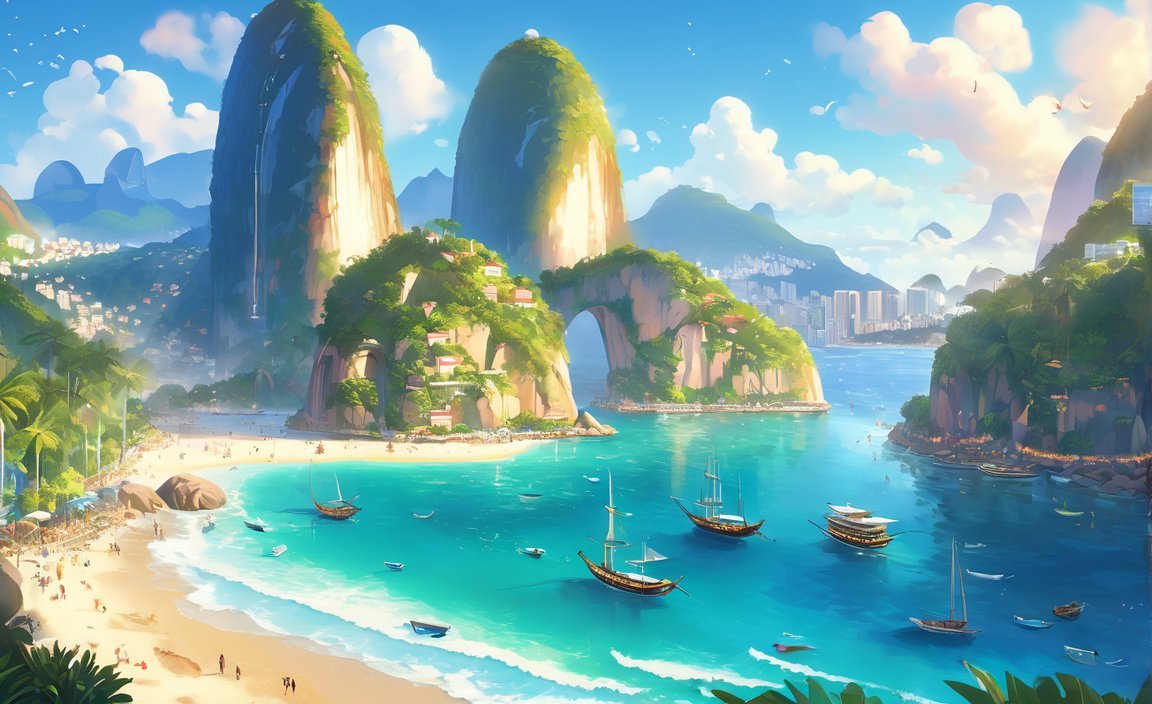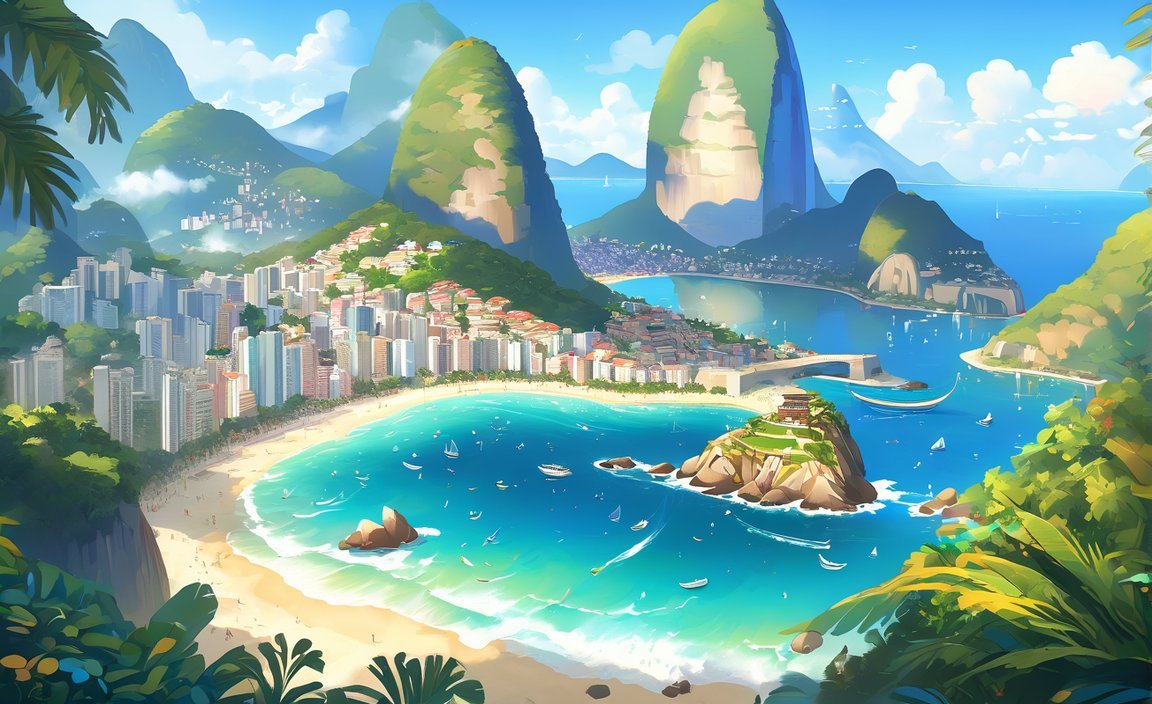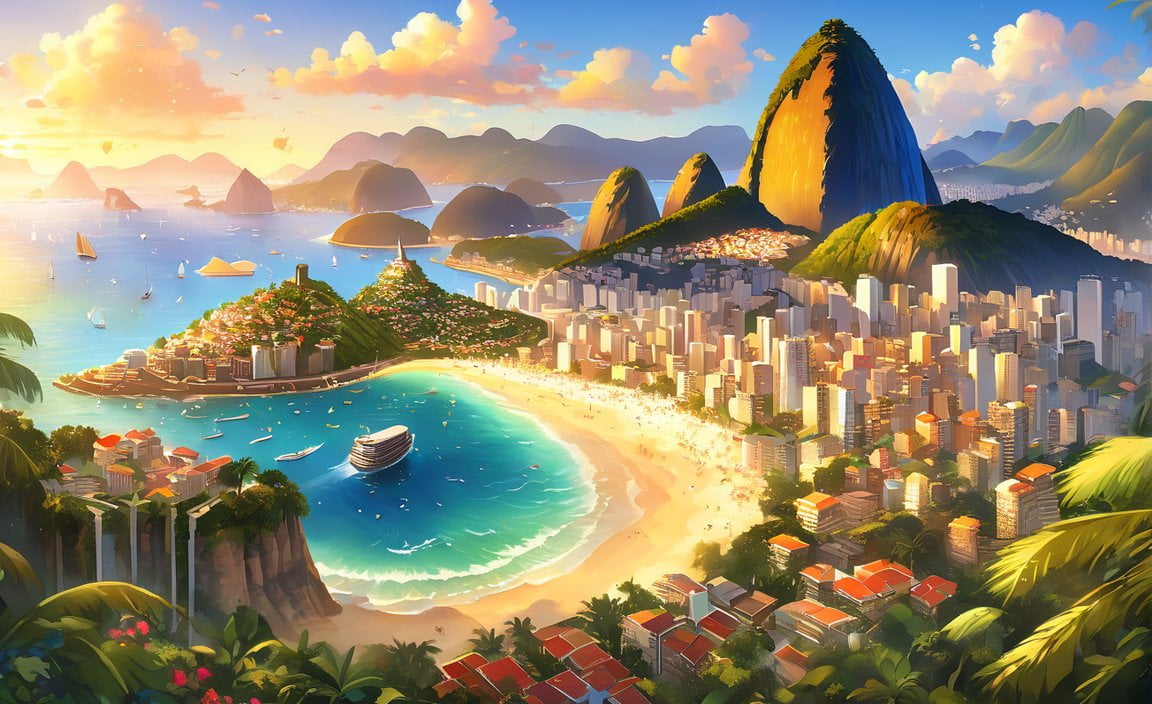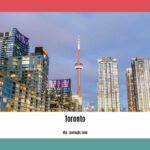Explore the Vibrant Marvels of Rio de Janeiro: Unveiling its Coordinates. Welcome to the captivating world of Rio de Janeiro, a city that pulsates with an energy like no other. Nestled along the Brazilian coastline, this enchanting destination boasts a rich tapestry of culture, history, and breathtaking landscapes. From the charming neighborhoods that brim with life to the stunning beaches that invite endless relaxation, Rio de Janeiro offers a sensory experience that leaves a lasting impression on all who visit. Join us as we delve into the coordinates of this vibrant marvel, uncovering its hidden gems and must-visit attractions, and embarking on an adventure that will ignite your wanderlust.

Key Takeaways:
- Rio de Janeiro is located at coordinates 22°54′40″S 43°12′20″W.
- The population of Rio de Janeiro is not mentioned in the context.
- The weather in Rio de Janeiro is not mentioned in the context.
- Some attractions in Rio de Janeiro are not mentioned in the context.
- The time zone of Rio de Janeiro is not mentioned in the context.
- The article includes several URL sources related to the coordinates, latitude, and longitude of Rio de Janeiro.
- One relevant URL source is “https://dateandtime.info/citycoordinates.php?id=3451190” which provides information about the geographic coordinates of Rio de Janeiro.
- Another relevant URL source is “https://latitude.to/map/br/brazil/cities/rio-de-janeiro” which provides information about the GPS coordinates of Rio de Janeiro.
Rio de Janeiro Coordinates
Rio de Janeiro, the vibrant city known for its lively culture and breathtaking landscapes, is located at coordinates 22°54′40″S 43°12′20″W. These geographic coordinates place the city in the southeastern part of Brazil, on the picturesque coast of the Atlantic Ocean.
The Gateway to Marvels
Rio de Janeiro’s coordinates serve as the gateway to a myriad of marvels waiting to be explored. Nestled between the mountains and the sea, the city offers a unique blend of natural beauty and cultural richness. As I delve into the captivating neighborhoods, stunning beaches, and pulsating nightlife, let’s take a closer look at the significance and implications of these coordinates.
Latitude and Longitude
Latitude and longitude form the foundation of coordinates, allowing us to pinpoint Rio de Janeiro’s exact location on the Earth’s surface. Latitude measures the distance north or south of the equator, while longitude indicates the distance east or west of the Prime Meridian. In the case of Rio de Janeiro, its latitude of 22°54′40″S places it just a stone’s throw away from the Tropic of Capricorn, enhancing its warm tropical climate.
Exploring the City
With Rio de Janeiro’s coordinates as our guide, let’s embark on an exciting exploration of this enchanting Brazilian city. Whether you’re wandering through the cobblestone streets of Santa Teresa, immersing yourself in the samba beats of Lapa, or experiencing the iconic Christ the Redeemer statue atop Corcovado Mountain, the city’s diverse neighborhoods and attractions will leave you in awe.
A Mecca for Beach Lovers
Rio de Janeiro’s coordinates also grant it access to a coastline adorned with stunning beaches. From the world-famous Copacabana and Ipanema beaches to the tranquil shores of Prainha and Barra da Tijuca, there’s a beach for every taste. Picture yourself basking in the sun, sipping a caipirinha, and embracing the vibrant beach culture that defines Rio de Janeiro.
Embracing the Nightlife
When the sun sets in Rio de Janeiro, the coordinates come alive with a pulsating energy that lures both locals and visitors alike. The vibrant nightlife offers a multitude of options, from samba clubs and live music venues to trendy bars and sophisticated restaurants. Allow the rhythm of the city to guide your steps as you dance the night away and immerse yourself in the lively Carioca spirit.
Connecting with History
Rio de Janeiro’s coordinates not only guide us to its energetic attractions but also connect us with its rich history. The city served as the capital of Brazil for nearly two centuries, leaving behind a legacy of colonial architecture and historical landmarks. From the majestic São Bento Monastery to the grandeur of the Imperial Palace, Rio de Janeiro’s coordinates unlock a portal to the country’s past.
Conclusion
As we navigate through Rio de Janeiro’s vibrant wonders, the coordinates 22°54′40″S 43°12′20″W serve as a constant reminder of the city’s unique position in the world. With each step we take, our exploration of this enchanting Brazilian city unveils a blend of natural beauty, cultural heritage, and a pulsating energy that can only be found in Rio de Janeiro. So embrace the coordinates, and let the marvels of Rio de Janeiro captivate your heart and soul.
Biomes of New Zealand – Explore the diverse and unique biomes found in New Zealand by clicking here: Biomes of New Zealand.
Geography pick up lines – Looking for a clever way to break the ice? Check out these hilarious geography pick up lines: Geography pick up lines!
Head of a Roman Patrician – Dive into the world of ancient Roman art and admire the exquisite craftsmanship of the Head of a Roman Patrician: Head of a Roman Patrician.
Key coordinates and landmarks in Rio de Janeiro
Rio de Janeiro, the enchanting Brazilian city, is renowned for its vibrant culture, breathtaking landscapes, and iconic landmarks. In this article, we will unveil the key coordinates and landmarks that make Rio de Janeiro a truly captivating destination.
Geographical Coordinates
Let’s start by exploring the geographical coordinates that pinpoint the location of Rio de Janeiro. The city is situated at 22°54.1668′ S latitude and 43°12.45′ W longitude. These coordinates place Rio de Janeiro on Brazil’s southeastern coast, along the beautiful Atlantic Ocean.
Source: Date and Time
UTM Coordinates
For those familiar with UTM (Universal Transverse Mercator) coordinates, Rio de Janeiro falls under zone 23K, with an easting of 683850.48228032 and a northing of 7466122.9434536.
Source: Date and Time
Geographic Coordinate Systems
Rio de Janeiro’s geographical features are truly captivating. Situated close to the Tropic of Capricorn, the city is located on Brazil’s Atlantic coast, with Guanabara Bay (Baía de Guanabara) serving as a prominent landmark. The shoreline of Rio de Janeiro stretches from east to west, offering stunning views and a diverse range of neighborhoods to explore.
Source: Wikipedia – Geography of Rio de Janeiro
Landmarks and Attractions
One cannot talk about Rio de Janeiro without mentioning its iconic landmarks and attractions. The city is home to some truly remarkable sites, including the famous Christ the Redeemer statue, perched atop Corcovado Mountain. Another must-visit landmark is Sugarloaf Mountain, which offers panoramic views of the city’s breathtaking scenery. And of course, no visit to Rio de Janeiro is complete without spending time at the world-famous Copacabana Beach.
Source: Top Place to Visit – Landmarks of Rio de Janeiro
Natural Features
Rio de Janeiro is blessed with natural wonders that add to its allure. The city is surrounded by coastal mountains, which separate the South Zone from the center and the North Zone. It is also nestled near the Tijuca Forest, the largest urban forest globally, offering a unique blend of urban settings and natural elements.
Source: Rio de Janeiro Geography
UNESCO World Heritage Site
Recognizing its exceptional blend of urban and natural beauty, Rio de Janeiro has been designated as a UNESCO World Heritage Site. The Carioca Landscapes between the Mountain and the Sea represent the city’s distinctive landscape and cultural importance.
Source: UNESCO World Heritage Centre
Key Takeaways:
- Rio de Janeiro’s geographical coordinates are 22°54.1668′ S latitude and 43°12.45′ W longitude.
- The city falls under UTM zone 23K, with coordinates of easting 683850.48228032 and northing 7466122.9434536.
- Rio de Janeiro is located on Brazil’s Atlantic coast, close to the Tropic of Capricorn, with Guanabara Bay and Cabo Frio as prominent landmarks.
- Iconic landmarks and attractions in Rio de Janeiro include Christ the Redeemer statue, Sugarloaf Mountain, Copacabana Beach, Tijuca Forest, Maracanã Stadium, and the Sambadrome.
- The city is surrounded by coastal mountains and is home to the largest urban forest in the world, the Tijuca Forest.
- Rio de Janeiro’s exceptional landscape and cultural significance have earned it the status of a UNESCO World Heritage Site.
Sources:
– Date and Time
– Wikipedia – Geography of Rio de Janeiro
In conclusion, Rio de Janeiro’s key coordinates and landmarks offer a glimpse into the city’s captivating beauty and rich cultural heritage. With its stunning natural features and iconic attractions, Rio de Janeiro truly stands as a vibrant marvel waiting to be explored.
Exploring the geographical features of Rio de Janeiro through its coordinates
Rio de Janeiro, situated at 22°54’S 43°12’W, is a city that offers a fascinating blend of urban life and natural beauty. Let’s dive deeper into the geographical features that make this Brazilian city truly remarkable.
Tijuca Forest: The Largest Urban Forest in the World
One of Rio de Janeiro’s standout geographical features is the Tijuca Forest, the largest urban forest globally. It has become an integral part of Rio’s charm and beauty as the city developed around this lush greenery. The Tijuca Forest showcases the city’s commitment to preserving its natural surroundings amidst urbanization.
Close to the Tropic of Capricorn
Situated close to the Tropic of Capricorn, Rio de Janeiro enjoys a tropical savanna climate (Aw) that borders on a tropical monsoon climate (Am). The city experiences hot and humid summers, with heavy rainfall between December and March. The mountainous areas in Rio de Janeiro receive more rainfall due to their barrier effect on the humid winds from the Atlantic Ocean.
Main Attractions: Parks, Beaches, and More
Alongside the Tijuca Forest, Rio de Janeiro is home to several remarkable natural attractions. The city boasts parks and ecological reserves like the Tijuca National Park, a UNESCO Environmental Heritage and Biosphere Reserve, and the Pedra Branca State Park, which houses Rio de Janeiro’s highest point. Nature enthusiasts should also visit the Botanical Garden and explore the stunning beaches, including the iconic Copacabana and Ipanema.
Environmental Concerns
While Rio de Janeiro’s beauty is unquestionable, the city faces environmental challenges. As an industrial hub, the metropolitan region wrestles with issues of environmental pollution. The Guanabara Bay suffers from residues such as sewage, oils, and heavy metals, affecting its biodiversity. Air pollution is another concern, with levels of particulate matter exceeding recommended limits. However, ongoing efforts to decontaminate the Rodrigo de Freitas Lagoon and Marapendi Lagoon are underway. Despite these challenges, the awe-inspiring beauty of Rio de Janeiro continues to captivate visitors.
Key Takeaways:
- Rio de Janeiro is home to the largest urban forest in the world, the Tijuca Forest, which showcases the city’s commitment to preserving nature amidst urbanization.
- The city’s coordinates position it close to the Tropic of Capricorn, resulting in a tropical savanna climate with hot summers and heavy rainfall.
- Besides the Tijuca Forest, Rio de Janeiro offers other natural attractions such as parks, ecological reserves, and stunning beaches.
- Environmental concerns, including pollution in the Guanabara Bay and air pollution, are being addressed to preserve Rio de Janeiro’s natural assets.
References:
[^1^]: Rio de Janeiro Geography – Climate, Weather, Temperature
[^2^]: Geography of Rio de Janeiro – Wikipedia
How the coordinates of Rio de Janeiro impact its climate and weather
With its vibrant neighborhoods, stunning beaches, and rich cultural heritage, Rio de Janeiro has long captivated travelers from around the world. But have you ever wondered how the coordinates of this enchanting city impact its unique climate and weather patterns? In this article, we’ll dive into the fascinating connection between Rio de Janeiro’s coordinates and its atmospheric conditions.
Understanding the Influence of Coordinates
Rio de Janeiro is situated at coordinates 22°54′40″S latitude and 43°12′20″W longitude, on the southeastern coast of Brazil along the Atlantic Ocean. These coordinates play a crucial role in shaping the city’s warm tropical climate. Located just below the Tropic of Capricorn, Rio de Janeiro experiences a pleasant mix of warm temperatures, ample sunshine, and occasional rainfall throughout the year.
Latitude and Climate
The latitude of Rio de Janeiro, marked by the coordinates 22°54′40″S, contributes to its tropical climate. As the city lies close to the equator, it enjoys a consistent amount of sunlight year-round, resulting in warm temperatures. The Tropic of Capricorn passes just south of Rio de Janeiro, indicating its position in the southern hemisphere and influencing its seasonal variations.
Longitude and Weather Patterns
Considering the longitude of Rio de Janeiro, which is 43°12′20″W, we find its proximity to the ocean. Coastal cities like Rio de Janeiro are often vulnerable to the effects of climate change due to their geographical positioning. Rising sea levels, increased storm activity, and other climate phenomena can significantly impact the weather patterns of these coastal regions.
Key Takeaways:
- Rio de Janeiro’s coordinates, at 22°54′40″S latitude and 43°12′20″W longitude, contribute to its warm tropical climate.
- The latitude, just below the Tropic of Capricorn, ensures a consistent amount of sunlight year-round, resulting in warm temperatures.
- The longitude of Rio de Janeiro, close to the ocean, makes it susceptible to climate change effects.
- Rising sea levels and increased storm activity can influence the weather patterns of coastal cities like Rio de Janeiro.
Sources:
- The Guardian – Brazil has experienced its eighth heatwave before southern hemisphere summer
- Foreign Policy – Rio de Janeiro facing the perfect storm of climate change
So come and explore the vibrant marvels of Rio de Janeiro, where the intertwining coordinates and atmospheric conditions create a truly unique experience. Immerse yourself in its warm tropical climate, bask in endless sunshine, and witness the undeniable enchantment of a city poised between the coastline and the vibrant energy of its streets.

FAQ
Q1: What are the exact coordinates of Rio de Janeiro?
A1: The latitude of Rio de Janeiro is 22°54.1668′ S and the longitude is 43°12.45′ W. [^1^]
Q2: What are UTM coordinates and zone for Rio de Janeiro?
A2: Rio de Janeiro falls under UTM Zone 23K, with an easting coordinate of 683,850.48228032 and a northing coordinate of 7,466,122.9434536. [^2^]
Q3: Where is Rio de Janeiro located geographically?
A3: Rio de Janeiro is situated on Brazil’s Atlantic coast, close to the Tropic of Capricorn. It is marked by Guanabara Bay (Baía de Guanabara) and is oriented east-west along its shoreline. [^3^]
Q4: What are some popular landmarks and attractions in Rio de Janeiro?
A4: Rio de Janeiro is home to iconic landmarks such as the Christ the Redeemer statue, Sugarloaf Mountain, and Copacabana Beach. Other attractions include Tijuca Forest, Maracanã Stadium, and the Sambadrome. [^4^]
Q5: Is Rio de Janeiro known for any natural features?
A5: Yes, Rio de Janeiro is surrounded by coastal mountains, which separate the city’s South Zone from the center and the North Zone. It is also located near the Tijuca Forest, the largest urban forest in the world. [^5^]
















